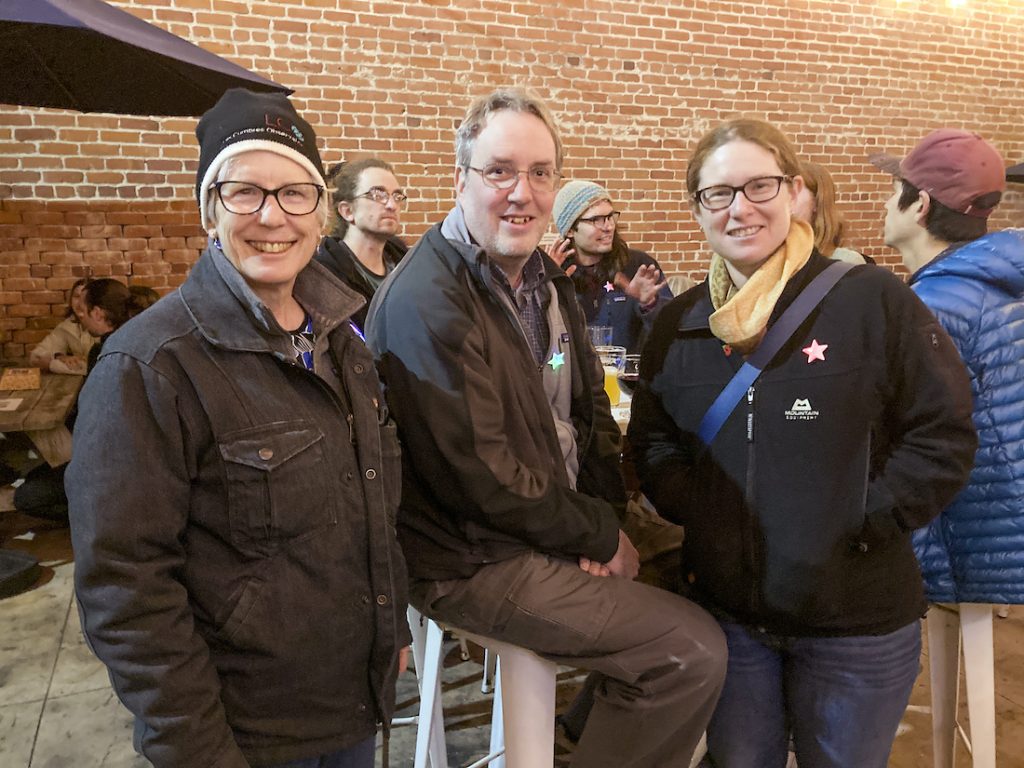The December Astro on Tap by Las Cumbres Observatory
On Thursday, December 14, the Las Cumbres Observatory (LCO) team held its “Astronomy on Tap” meeting at M. Special on State Street. These events are an all ages and pet friendly info session on current astronomy science and news. The LCO team has raffle tickets that support the event with winners getting the coveted LCO beer glasses, and other goodies, along with t-shirts and posters available for purchase – organized by Sandy Seale PhD, LCO’s Director of Development.
Attendees included LCO Director Dr. Lisa Storrie-Lombardi, with her husband, astrobiologist Michael Storrie-Lombardi, astroscientists who have been covered in the MJ by me; Tim Lister PhD on the DART Mission team and who was recently awarded with a Minor Planet named in his honor for his work [ref: MJ July 25, 2023]; and Rachel Street PhD [ref: MJ September 21, 2021], who continues her work with the Rubin Observatory team to get it up and ready for recording data accurately. Lister shared that the DART mission has been completed and he has submitted an application for a grant from NASA to work with the European Space team on the continuance of the project. Street added that Rubin should be up by 2025.
The Astro on Tap program that evening started with its newest post-doctoral fellow Katarzyna Kruszyńska, who is on Street’s team. Her research focus is gravitational microlensing events, searching for solitary black holes and exoplanets, working with Gaia data, and preparing for Rubin Observatory’s launch. She is from Warsaw, Poland, and her interests include drawing comics and fashion.
Kruszyńska presented “Gaia: 10 years of Observing the Galaxy in Motion.” Her key talking points were how stars are measured in terms of their distance from Earth, their compositional elements, and their age and evolution. She traced the history of how such measurements were ascertained including the Cosmic Distance Ladder, levels of brightness, and tracking movement. She traced concepts from Hipparchus in 190 BC discovering the Earth wobbles to Tycho Brahe’s precise measuring (within one to two minutes) of the arc for the positions and movements of the planets, acknowledging Thomas Henderson of South Africa in 1832-1833 for the first successful stellar parallax measurements.
The lead Gaia scientists were Lennart Lindegren and Michael Perryman, who in 1993 proposed the use of CCDs and mirrors for telescope observations. They worked for the European Space Agency’s Gaia project, a space telescope designed to measure the positions of billions of stars with unprecedented precision. It launched on December 19, 2013, and is located at the L2 Lagrange point. The James Webb telescope will not be located precisely at L2, but will move in a halo orbit around L2 as it orbits the Sun.

Gaia tracks the distance and movement of one billion stars in the Milky Way Galaxy; provides a 3D map of the Milky Way Galaxy; adds data on “stellar” properties like the temperature and chemical composition of the stars; maps bodies in the solar system; and tracks the age, evolution, brightness, distance, composition, and measures the dust of the Milky Way and asteroids.
There is a Citizen Science Project for it called Gaia Vari; visit the link in the 411.
After a break and a few Q&A, it was time for the Astro News, presented by LCO lead astroscientist Andy Howell PhDand new to LCO Carolina Capetillo PhD. They gave briefs on the Gemini meteor showers visible now through December 24; updates on the James Webb Telescope viewing of Cassiopeia with references to NASA’s Instagram, bragging about the White House Advent calendar including a photo from the Webb Telescope; the not-so-dangerous solar storms recently reported in the news as such; and Howell finishing up the ride with the International Space Station scientists losing their tool bag in space while working. Said tool bag is now visible from Earth, and “The stray tool bag will float around our planet for a few months, until tendrils of Earth’s atmosphere pull it back for a safe burn-up high above the surface at roughly 70 miles (113 kilometers) in altitude.”To Howell’s credit, he cited the sarcastic news bits from the UK’s Daily Mail about the female ISS scientists as “misogynistic,”and added,“men have been losing shit in space for years!” – with the most recent being the lost tomato by ISS Frank Rubio eight months ago that was recently found by the crew [no he did not eat it].
The MJ wishes a Happy Holidays to the LCO team, and may the Force be with you!
411: https://lco.global
Gaia Citizen Project:







